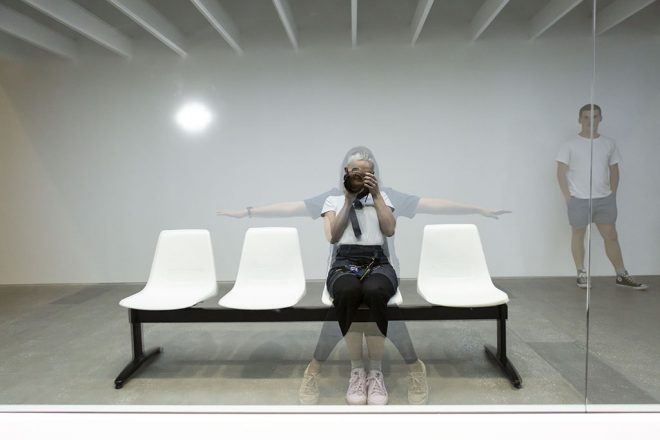Taiwanese Artist Joyce Ho On Trusting Your Work to Speak For Itself


Showcasing the best live events in Queensland.
“Sometimes…when you target your audience too specifically, you underestimate the potential ideas or messages your work is capable of,” says interdisciplinary artist Joyce Ho, whose work, is currently on display at The 9th Asia-Pacific Triennial of Contemporary Art (APT9) in Brisbane.
Joyce Ho’s work defies hasty first impressions, encouraging the audience to engage more fully through repeated interactions. “I think I initiate my art-making whenever I suddenly become aware of something in my life,” she tells Junkee, when asked about how she seeks to challenge conventional ideas in her work. “It might be a response to an object, an action, or something on the verge of disappearing, or something that I sense is inconsistent with our present daily lives.”
Ho embraces the possibility of things going wrong in her work, too: “I think it creates a certain error, something dramatic. It usually happens when in the situation of social exchange, consumption, or activities that involve certain orders in our daily lives in the system. I fix my gaze on it, then I’ve made an instinctive start on my creative work.”
APT9 includes several works by Ho, intended for different audiences: “I was really interested in showing my practice as a whole – through several installations, rather than one single work.” Works featured in the Triennial include UN-COVERED LIBRARY 2018, which is installed in the Children’s Art Centre at GOMA.
“I think we have a very different relationship to books in the present day,” Ho says of the literature-inspired work. “I think our relationship with books – the physical object, is breaking down. So too is our relationship with media and gestures.”
UN-COVERED LIBRARY is a bright yellow interior filled with books that are covered in paper, so the titles and illustrations are hidden from plain sight. Children are encouraged to sit and choose a book to read. When finished, they can give the book a new title and cover design and return it to its original place for someone else to enjoy.
“The work has two different layers,” Ho explains. “One is to encourage children to create their own narratives without knowing the set narratives given, and the other is to frame the actual physical gesture of reading.”
Ho was delighted by the level of creativity unleashed by children engaging with UN-COVERED LIBRARY. She says: “There are some covers and titles they’ve created for the books that are amazingly poetic!” She hopes that the work not only appeals to younger audiences, but also extend itself to encourage play and imagination in adults, too.

Image: Natasha Harth / QAGOMA
Other APT9 installation works are Overexposed Memory (2015), a video-based work, and On the second day, Saturday, your three minutes… (2017), which is modeled on a modern-day waiting room and encourages Gallery visitors to sit opposite each other and wait while other members of the audience watch on, also becoming part of the artwork.
Ho discusses how collaboration has greatly influenced her practice, particularly a decade-long creative partnership with performer Vera Sung. “Vera has been my ‘proxy’ as an artist and, in our works, we explore the feminine in relationship to the service and labors of the cultures in Taiwan.”
Over time, they’ve both observed shifts in how women interact and socialise: “How we serve, how we bow…and how the etiquette changes from a female perspective. It is through these observations that we discover the shifts in gender roles, from sexual to mutual, from objects to poems.”

Image: Natasha Harth / QAGOMA
The Taiwan-born artist enjoys being part of an art scene where origin and cultural diversity bleed into one another, and sparks new ideas and life into her art practice: “There are a lot of rituals and gestures in our everyday lives that are hard to differentiate from their origins, and that is what I am most interested in.”
For Ho, one of the best aspects of being an artist is not knowing how the audience will respond to something: “Some artists would like to be way ahead, and some artists would like the audience to be immersed in their works. I think I am the kind of artist that likes to measure. I have different measurements when I use different mediums for my works; it really depends on the context of the works.”
That said, Ho still aims to practice, absorb and anticipate as a creator of the works: “I try to be as precise as I can, so I often take a lot of time rehearsing for my exhibitions, which means days of walking around the works and trying to grasp the feeling and the emotion the audience might have in response to it.”
Ho doesn’t think she’s in a place to give advice to younger artists. “I am in a state where I have freedom to express my artistic practice, and I know a lot of artists from different cultures might not have the opportunity.”
For her, art presents the freedom to create multiple readings, expressions, and possibilities, depending on the context. “Art really has no function,” she points out. “The only function is to create a void for the viewers to have their own interpretations of your artworks.”
—
Experience the Joyce Ho’s artworks and more at The 9th Asia Pacific Triennial of Contemporary Art (APT9) at QAGOMA Brisbane until April 28, 2019. Visit the website for full details.

